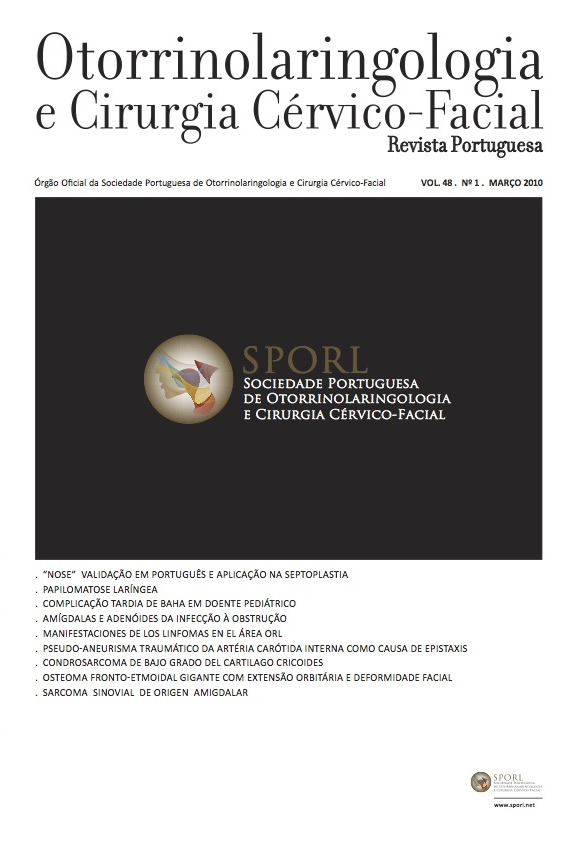"NOSE" Validation in Portuguese and application in septoplasty
DOI:
https://doi.org/10.34631/sporl.256Keywords:
nasal obstruction, septoplasty, NOSEAbstract
Nasal obstruction is one of the most common symptoms, and septoplasty one of the most frequently performed surgeries in otorhinolaryngology. In order to evaluate the subjective response to septoplasty the AAO-HNS implemented the NOSE scale, developed and validated for North-Americans.
The authors carried out the adaptation and validation of the NOSE scale for Portuguese language and population, allowing its further use in Portuguese studies. Subsequently, the validated Portuguese NOSE scale was employed in the evaluation of subjective results in a cohort of 100 patients that underwent septoplasty. A pre-operatory NOSE value of 74,6 was found, in contrast to 19,3 found in the post-operatory period.
The results statistically confirmed the success of septoplasty in the improvement of nasal obstruction in patients with deviated nasal septum. The Portuguese NOSE scale confirmed to be a simple, rapid and reliable method for the evaluation of subjective nasal obstruction.
Downloads
References
Kjaergaard T, Cvancarova M, Steinsvag SK. Does nasal obstruc- tion mean that the nose is obstructed? Laryngoscope. 2008 Aug; 118(8):1476-81.
Stewart M, Witsell D, Smith T, Weaver E. Development and Validation of the Nasal Obstruction Symptom Evaluation (NOSE) Scale. Otolaryngol Head Neck Surg 2004; 130: 157-163
Hill MM, Hill A. Investigação por Questionário. 1ª Edição. Edições Sílabo, Lisboa. 2000
Cronbach LJ. Coefficient alpha and the internal structure of tests. Psychometrika. 1951. 16, 297-334.
Pestana MH, Gajeiro JN. Análise de dados para as Ciências Sociais, a complementaridade do SPSS. 3ª Edição. Edições Sílabo, Lisboa. 2003
Stewart MG, Smith TL, Weaver E, et al. Outcomes after nasal septoplasty: results from the Nasal Obstruction Symptom Evaluation (NOSE) study. Otolaryngol Head Neck Surg 2004; 130:283-90
Samad I, Stevens HE, Malonet A. The efficacy of nasal septal surgery. J Otolaryngol. 1992; 21:88-91; 22 (5): 502-5
Hwang PH, McLaughlin RB, Lanza DC et al. Endoscopic septoplasty: indications, technique and results. Otolaryngol Head Neck Surg 1999; 120:678-82
Broms P. Johnson B, Malm L. Rhinomanometry: a pre and pos-operative evaluation in functional septoplasty. Acta Otolaryngol (Stockh) 1992; 94:523-9






